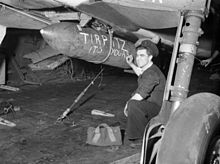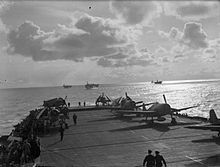- Operation Tungsten
-
Operation Tungsten was a British naval operation during World War II. it was one of a number of aerial attacks on the German battleship Tirpitz while she was in Norwegian waters. The attack was carried out aircraft of the Fleet Air Arm (the air units of the Royal Navy) against Tirpitz as she lay in Altenfjord in northern Norway. "Tungsten" took place in April 1944 and was a qualified success; Tirpitz was not sunk, but needed extensive repairs and was put out of action for several months. The British lost three aircraft.
Contents
Background
During the arctic campaign Tirpitz exerted an influence out of all proportion to her actual achievements, a striking example of the Fleet in Being principle. While Tirpitz was operational, Allied naval strategy had to take account of her, the allies had to guard against the possibility of a sortie against the arctic convoys, which tied down much of the strength of the British Home fleet. A series of attacks were made against Tirpitz while she was in harbour, in order to sink, or at least put her out of action. In 1943 Operation Source, the attack by British X-craft ( midget submarines) had incapacitated Tirpitz for a period of six months. In spring of 1944 Tirpitz repairs were nearing completion and the allies had again to consider neutralizing her as a threat.
Plan
Tungsten called for an attack by an aerial strike force which would attack Tirpitz in her mooring in Kaa fjord (a branch of Altenfjord). A force of 130 aircraft was assembled: 42 Barracuda bombers, and 88 fighters; 28 Corsairs, 20 Hellcats and 40 Wildcats. These would be brought to the target in two carrier groups and their escorts.
Force One comprised two battleships, Anson and Duke of York, aircraft carrier Victorious, cruiser Belfast, and five (later six) destroyers. Force One would sail as distant cover for an Arctic convoy before making rendezvous with Force Two for the attack. Force Two comprised the fleet carrier Furious, three escort carriers, Emperor, Pursuer, and Searcher, four cruisers and four destroyers, which sailed directly for the RV point. A fourth carrier, Fencer, carried an anti-submarine defence squadron, of 14 Seafires, 8 Martlets and 6 Swordfish. These would not take part in the raid itself.
Training began in early 1944, using a bombing range on Loch Eriboll where a full scale target of Tirpitz and the area defences had been erected. The original plan called for a strike in March, but repairs to Victorious delayed the operation for several weeks, to coincide with convoy JW 58. However the delay meant the force could be equipped with the new 1600 lb armour-piercing bomb, in use for the first time. The plan was for the air strikes to take place in two waves, each of a mixed group comprising Barracudas, as bombers, Wildcats to strafe the AA defences on Tirpitz, Hellcats to attack the land-based flak batteries, and Corsairs as air cover against German fighters.
Action


Fleet Air Arm crewman chalks a message on the 1,600 pound bomb carried by a Fairey Barracuda of HMS Furious 

Grumman Hellcats on HMS Emperor, with other ships of the British force in background On 30 March Force One left Scapa Flow to keep track with JW 58; V Adm. Bruce Fraser, in Duke of York commanding for the JW 58 operation, and V Adm. Moore, in Anson for "Tungsten". Later on 30 March Force Two left Scapa, under R Adm. La Touche Bisset. JW 58's escort proved well able to look after itself ( despite numerous U-boat attacks no ships were lost, while 3 U-boats were destroyed by the escorts) so Moore was able to detach 24 hours early, allowing "Tungsten" to be brought forward. On 2 April during the afternoon the two forces met, and by the early hours of 3 April were in position for the attack.
At 0437 on 3 April, the first strike of 21 Barracudas departed with their attending fighters and led by the Strike Leader Lt Cdr Roy Baker-Falkner DSC RN.[1][2]. The bombers and their escorts headed for Norway, arriving over the target at 0528. Despite picking up the attacking force on radar, Tirpitz had just four minutes warning, and was unready as the aircraft attacked. The first wave of bombers attacked while the fighters strafed the decks of the Tirpitz to suppress anti-aircraft fire. The bombers of the first wave were carrying general purpose bombs, which would prove effective against the lightly armoured AA positions and their crews, alongside heavier armour-piercing bombs. Three hits were scored with the 1600 lb bombs, and five with 500 lb bombs, while severe casualties were caused amongst the crews manning Tirpitz's flak guns. One Barracuda was shot down.
An hour later the second wave attacked, scoring a further five hits, despite Tirpitz's defenders deploying a smoke-screen to cover the area. Again fighters strafed the battleship from low level. The strike force also attacked other ships in Kaafjord, sinking a patrol boat and damaging three other vessels. One Barracuda was shot down from this strike force also, while a Hellcat was forced to ditch on returning to the carriers. By 08:30 the attacking aircraft had landed on their carriers and the task force was turning for home.
With the return of the aircraft Moore decide not to mount a further attack, but to return to Scapa, a fortunate decision as the weather changed during the night of 3/4 April making further operations impossible. The combined force returned to Scapa on 6 April without incident.
Outcome
British losses were 2 Barracudas shot down and 1 damaged Hellcat that was ditched deliberately. Nine airmen were killed.
The Tirpitz had suffered flooding caused by near misses but the machinery was untouched - none of the bombs had penetrated the deck armour. The radio aerials had been reduced, the anti-aircraft armament had been damaged, 122 men had been killed and a further 316 wounded. Tirpitz would be out of action for at least another month. The armour-piercing bombs may have been less effective because they were dropped at lower heights than intended.
Forces involved
Force I
- Capital ships
- Destroyer escort group
Force II
- Carriers
- Cruisers
- Destroyers
- HMS Virago
- HMS Verulam
- HMS Vigilant
- edit] Air
- No. 8 Wing (Furious)
- 830 Naval Air Squadron, Fairey Barracuda
- 827 Naval Air Squadron, Fairey Barracuda, (temporarily on Victorious)
- Supermarine Seafire (force defence)
- No. 52 Wing (Victorious)
- 829 Naval Air Squadron Fairey Barracuda
- 831 Naval Air Squadron, Fairey Barracuda (temporarily on Furious)
- 1834 Naval Air Squadron, Chance-Vought Corsair
- Searcher
- Pursuer
- 881 Naval Air Squadron Wildcat (20)
- Emperor
- 882 Naval Air Squadron Grumman Hellcat (10)
- Fencer
- Wildcats (force defence)
- 2nd Wave fighter cover
- 1826 Naval Air Squadron, Corsairs (10)
- 896 Naval Air Squadron, Wildcats
- 898 Naval Air Squadron, Wildcats
- 804 Naval Air Squadron, Hellcats (10)
Notes
- ^ Operation "Tungsten"
- ^ I Was There! - We Struck at and Crippled the Mighty Tirpitz, The War Illustrated, May 12, 1944.
References
- Clay Blair : Hitler’s U-Boat War Vol II (1998) ISBN 0-304-35261-7
- Paul Kemp : Convoy! Drama in Arctic Waters (1993) ISBN 1-85409-130-1
External links
See also
- German battleship Tirpitz for context of attacks on Tirpitz
- No. 8 Wing (Furious)
Categories:- World War II operations and battles of the Western European Theatre
- Aerial operations and battles of World War II
- Military operations of World War II involving Germany
- Battles and operations of World War II involving the United Kingdom
Wikimedia Foundation. 2010.
